

























Boeing KC-97G "Stratotanker"
United States — four-engine tanker aircraft
Archive Photos
Boeing KC-97G Stratotanker (AF 53-0272) at the Milestones of Flight Museum, Foxfield, Lancaster, California (Photos by John Shupek)
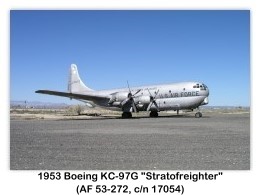
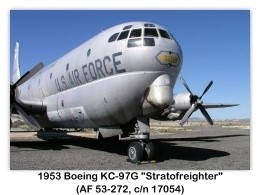
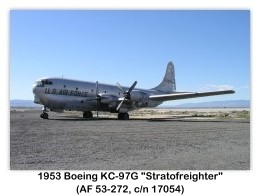
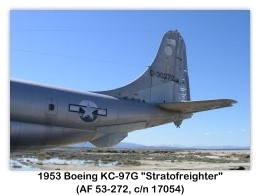
Boeing KC-97G/L "Stratotanker" (AF 53-0363) at the March Field Air Museum, Riverside, California (Photos by John Shupek)
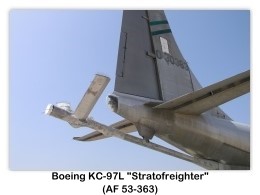



Overview
- Boeing KC-97 Stratotanker
- Role: Strategic tanker
- Manufacturer: Boeing
- Primary users: United States Air Force; Spanish Air Force
- Number built: 816
- Developed from: C-97 Stratofreighter
The Boeing KC-97 Stratotanker was a United States strategic tanker aircraft based on the Boeing C-97 Stratofreighter. For many years, it was the backbone of the United States Air Force’s tanker fleet until replaced by the Boeing KC-135.
Design and Development
The KC-97 Stratotanker was an aerial refueling tanker variant of the C-97 Stratofreighter (which was itself based on the B-29 Superfortress), greatly modified with all the necessary tanks, plumbing, and "flying boom." The cavernous upper deck was capable of accommodating oversize cargo accessed through a very large left-side door, or transferable jet fuel was contained in tanks on the lower deck. Both decks were heated and pressurized for high altitude operations.
Operational History
The USAF began operating the KC-97 in 1950. It purchased a total of 816 KC-97s from Boeing, as opposed to only 74 of the C-97 cargo version. The KC-97 used piston engines, fueled by aviation gasoline, but it carried jet fuel for its refueling mission. It therefore used independent systems for both types of fuel.
These tankers were vitally important to the world-wide B-47 Stratojet strategic operations. An example is the support of Arctic reconnaissance flights from Thule Air Base. The struggle to start and operate this complex airplane at temperatures of -40°F was a triumph. Navigation in the Arctic conditions required great skill.
While it was an effective tanker, the KC-97s slow speed and low operational altitude complicated refueling operations with jet aircraft. B-52s typically lowered their flaps and rear landing gear to slow the aircraft enough to refuel from the KC-97. In addition, a typical B-52 refueling engagement profile would involve a descent that allowed the aircraft pair to maintain a higher Airspeed (220-240 knots). In the early 1960s, TAC added J-47 jet pods from retired KB-50 tankers to produce the KC-97L. The jet pods increased performance and made the KC-97 more compatible with jet aircraft.
In 1956, SAC began phasing out the KC-97 in favor of the KC-135. KC-97s continued operating with TAC, the Air Force Reserves, and Air National Guard units. They were finally retired completely in 1978, when the Texas and Utah Air National Guards exchanged their KC-97Ls for C-130s and KC-135s, respectively.
Variants
- XC-97 — prototype, 3 built.
- YC-97 — cargo transport, 6 built.
- YC-97A — troop carrier, 3 built.
- YC-97B — fitted with 80 airliner-style seats, one in 1954 redesignated VC-97D, retired to MASDC 15 December, 1969.
- C-97A — transport, 50 built.
- KC-97A — Three C-97As were converted into aerial refueling tankers with rear loading door removed and a flight refueling boom added. After the design was proven, they were converted back into the standard C-97A.
- C-97C — medical evacuation transports, 14 C-97As converted during the Korean War (also designated MC-97).
- VC-97D — staff transport conversions, 1 YC-97A, 2 C-97As converted, plus the YC-97B. Later designated C-97D.
- C-97E — KC-97Es converted to transports.
- KC-97E — aerial refueling tankers with rear loading doors permanently closed, 60 built.
- C-97F — KC-97Fs converted to transports.
- KC-97F — 3800 hp R-4360-59B engines and minor changes, 159 built.
- C-97G — 135 KC-97Gs converted to transports.
- EC-97G — ELINT conversion of three KC-97Gs. 53-106 was operated by the CIA for covert ELINT operations in the West Berlin Air Corridor.
- KC-97G — dual-role aerial refueling tankers/cargo transportation aircraft. KC-97G models carried underwing fuel tanks. 592 built.
- GKC-97G — Five KC-97Gs were used as ground instruction airframes.
- JKC-97G — One aircraft was modified to test the underwing General Electric J47-GE-23 jet engines, and was later designated KC-97L.
- HC-97G — KC-97Gs converted for search and rescue operations, 22 converted.
- KC-97H — One KC-97F was experimentally converted into a hose-and-drogue refueling aircraft.
- YC-97J — two KC-97G conversion with four 4250 kW Pratt & Whitney YT34-P-5 turboprops, dropped in favor of the Boeing KC-135 Stratotanker.
- C-97K — KC-97Gs converted to troop transports.
- KC-97L — 81 KC-97Gs modified with two J47 turbojet engines on underwing pylons.
Operators
- Spain: Spanish Air Force
- United States: United States Air Force
Specifications (KC-97G)
General Characteristics
- Crew: five (two pilots, navigator, flight engineer, boom operator)
- Capacity: 9,000 gal of jet fuel
Dimensions
- Wingspan:
- Length: 110 ft 4 in (33.64 m)
- Height: 38 ft 3 in (11.6 m)
- Wing area: 1,769 ft² (164.34 m²)
Weights
- Empty weight: 82,500 lb (37,450 kg)
- Loaded weight: 153,000 lb (69,460 kg)
- Max permissible loaded weight: 175,000 lb (79,450 kg)
Powerplant
- 4 × Pratt & Whitney R-4360-59B radial engines, 3250-hp (2423 kW) each
Performance
- Maximum speed: 375 mph (600 km/h)
- Cruise speed: 300 mph (480 km/h)
- Operating Range: 4,300 mi (6,880 km)
- Service ceiling: 35,000 ft (10,675 m)
References
- Shupek, John. Photos, copyright © 2009 Skytamer Images. All Rights Reserved
- Wikipedia, the free encyclopedia. KC-97 Stratotanker, 8 December 2009
- Bridgman, Leonard, "Boeing: The Boeing Stratofreighter." Jane’s All The World’s Aircraft 1955-56. Jane’s All the World’s Aircraft Publishing co. Ltd., London, 1955. pp. 229







































































